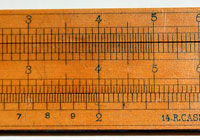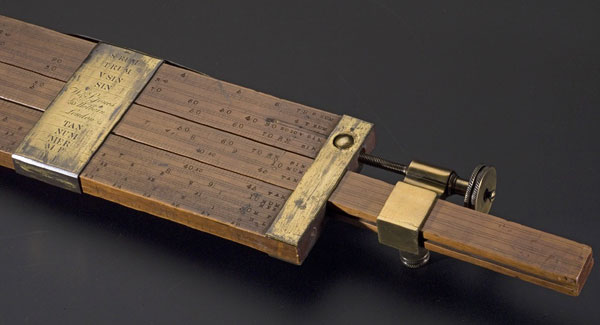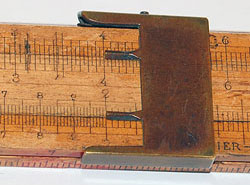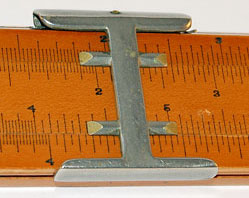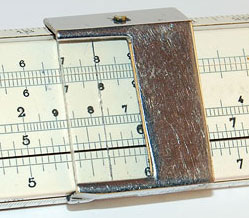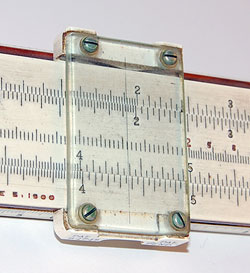 |
|
|
|

|

|
How the Slide Rule got its Cursor |
|
|
|
|
The iconic slide rule, long identified with the science and engineering professions before the advent of the electronic calculator, had two sliding components that set it apart from an ordinary rule: the slide running down the center of its body, and the transparent hairline cursor (also called runner) that moved over both body and slide. This configuration was so standard and universal in the 20th century, that few of the countless engineers who used it could imagine any other; and yet for most of its 300 years the slide rule had no cursor at all, and when it got one, it looked quite different... |
|
|
|
 A standard slide rule, as depicted in a college textbook from 1947 |
|
|
|
The evolution of the standard straight slide
rule, or slipstick as it was nicknamed in its heyday, is an
interesting one to follow because the same basic principle evolves
through a sequence of progressively more effective designs,
culminating in the familiar form that had helped put a man on the
moon in the sixties. As a collector interested in the evolution of
technology in time, I made an effort to acquire one representative
of each stage in this evolution, and have finally secured all but
the very earliest (for items pre-dating the 19th century, rarity and
price do conspire against the collector!). This article uses photos
of the items I have – and one that I don’t – to illustrate the
history of the straight logarithmic slide rule and its cursor.OriginsThe first logarithmic calculating rules did not slide at all... they used fixed scales on a wooden rule that allowed distances to be measured and added using a pair of dividers. This "Gunter's Rule" was the original device introduced by Edmund Gunter in 1620, which remained in use for some two centuries. |
|
|
|
 A mid-19th century Gunter's Rule (Click photo to enlarge) |
|
|
|
The first slide rule, constructed by William Oughtred in 1622, essentially put two Gunter scales next to each other, so that distances along the scale could be added directly by sliding the scales against each other. This idea remained for three centuries at the heart of every slide rule made. |
|
|
|
 |
|
|
|
Before the cursor |
|
|
|
 A Coggeshall carpenter's rule, late 19th century |
|
|
|
The earliest slide rules took many forms, but by the late 17th century had standardized on a few useful form factors, among them the Coggeshall carpenter’s rule. This instrument had a variety of useful scales and tables on one side and a standard 2-foot measuring rule on the other. The logarithmic calculating function used the narrow slide in one of its legs (For more, see this article). |
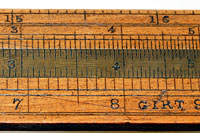 Click photo to enlarge |
|
|
|
Another standard form factor was used extensively in Ullage rules, which were used to calculate the excise tax on alcoholic beverages based on alcohol content and liquid depth in barrels of various shapes. The variety of calculations required ran into a problem: to calculate (multiply or divide) or convert between different quantities one needs to move from a number on one scale to the number at the equivalent point on another scale. This required the two scales to touch each other, so the equivalent points could be pinpointed accurately. The way to achieve this was to make a wide rule with as many pairs of scales as were required; in particular many sliding interfaces were needed, which was solved by having not one but two slides, with scales on both sides, for a total of eight interfaces (compared to two on the Coggeshall). |
|
|
|
 An Ullage slide rule, ca. 1900 (Click photo to enlarge) |
|
|
|
Engineers, meanwhile, needed to do the
generic calculations of multiplication, division, and square roots;
and for that purpose James Watt, the inventor of the steam engine
that powered the industrial revolution, devised about 1790 a simple
and convenient slide rule called the “Soho” (after the location of
Watt’s workshop in Birmingham). This rule had four scales, two on
the body (the fixed part) and two on the central slide. The top
three of these are two-cycle logarithmic scales (running from 1-100)
and the bottom one is one cycle (1-10). This allowed one to multiply
and divide with reduced accuracy on the top two scales, and to do
squares and square roots on the bottom two when they were aligned
properly. One couldn’t, however, multiply with the greater accuracy
that the single-cycle scale would allow were there a matching one
sliding above it, on the slide, which is curiously lacking. The
slide carries two identical scales, wasting one interface. Watts’s design spread soon to the continent. The Soho rule shown here is a beautiful exemplar, having been made by the renowned Gravet-Lenoir workshop in Paris near the middle of the 19th century. |
|
|
|
 Gravet Lenoir "Soho" Slide Rule, mid 19th century (Click photo to enlarge) |
|
|
|
Who invented the Cursor (or, as it was sometimes called, Index, indicator, or Runner) is debatable. There is mention of some form of cursor devised by Isaac Newton in 1675, and another is described by Frenchman Philippe Mouzin in 1837. The earliest cursor I’ve seen myself is on the slide rule designed in Britain by John Robertson in 1775. This massive rule has numerous scales, one slide, and a brass cursor that is a simple rectangle that can slide along the scales, providing the perpendicular line with its straight edges. |
|
|
|
I don’t own one, but I’ve been shown it by master collector Bob Otnes, and can show you a picture kindly provided to me by the National Museum of Scotland of a sample in their collection. |
 Robertson slide rule, late 18th century |
|
|
|
|
|
|
|
With Robertson’s cursor you can move between
the various scales at will (and keep track which is which, given the
legend on the cursor itself). That such a useful idea was left out
of the Soho design that came years later is probably due to the fact
that before the industrial revolution each inventor would devise his
own instrument, and the dissemination of new ideas was limited. This
would change in the 19th century.Mannehim’s innovationThe cursor came of age in 1851, thanks to a French artillery officer, engineer, and later professor of mathematics called Amédée Mannheim. Mannheim devised a slide rule with two two-cycle log scales and two single cycle scales, and added a brass cursor to allow moving between them. He may not have invented the cursor, but he had the practical streak in him that allows some inventors to influence the real world. He took this design to the Tavernier-Gravet firm – the successor to Gravet-Lenoir – and had them produce it as a standard item in their product line. You can see my exemplar of this rule here. |
|
|
|
 Mannheim slide rule by Tavernier-Gravet, late 19th century (Click photo to enlarge) |
|
|
|
 Mannheim slide rule, late 19th century (Click photo to enlarge) |
|
|
|
 Regle Beghin by Tavernier-Gravet, 1911 (Click photo to enlarge) |
|
|
|
 K&E 4053-3 slide rule, early 20th century (Click photo to enlarge) |
|
|
|
The Duplex rule Meanwhile it became obvious that it
would be nice to use both sides of the slide rule for calculation,
and the way to do this was invented by William Cox in 1891. His
open-frame configuration allowed the slide to be visible from both
sides of the body. For this to give maximum utility he needed a way
to move between scales on opposite sides, and this he achieved by
making the cursor – the all-brass version, originally – wrap around
the entire rule, with the chisel points on both sides aligned to
each other. The specimen I have is a model 4070, produced by K&E to
Cox’s patent starting in 1901. |
|
|
|
 K&E 4070 Duplex slide rule, 1901 model (Click photo to enlarge) |
|
|
|
 K&E 4061 Duplex slide rule, 1901 model (Click photo to enlarge) |
|
|
|
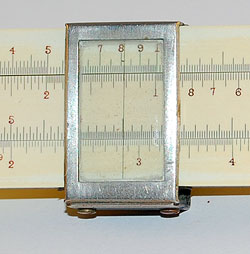 |
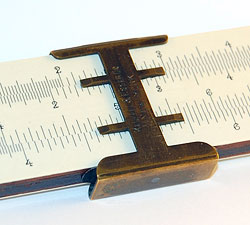 Click a photo to enlarge |
|
|
|
Et cetera, et ceteraBy 1900 we have all the optimal form factors for a straight slipstick: the one-sided rule with glass cursor derived from the Mannheim, and the two-sided duplex invented by Cox. From then on, all that was left to do is introduce better materials, notably plastic, and add more and revised scales, which could number upward of 30 on the largest duplex rules. Of course, ingenuity and experimentation continued to play their hands as makers tried to improve the cursor with various tricks; here are three photos of some diverse 20th century cursors. |
|
|
|
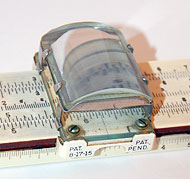
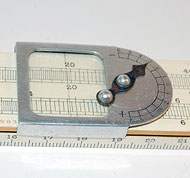
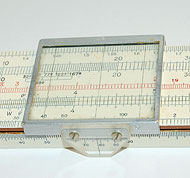 Click a photo to enlarge |
|
|
|
Home | HOC | Fractals | Miscellany | About | Contact Copyright © 2012 N. Zeldes. All rights reserved. |
|
